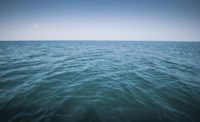Viral illnesses, seizures, musculoskeletal problems, and eye injuries were among the health problems that seafarers far from land sought medical help for from January 2014 to July 2016, through a telemedicine company that serves shipping companies and their workers.
(Pictured above: Crab boats moored in Dutch Harbor, Alaska, with alpenglow on Mt. Ballyhoo in the background. Photo from NIOSH.)
A study funded by NIOSH and conducted at the Yale University School of Medicine provides a fascinating glimpse into the challenges of providing health care to workers who are nowhere near health care facilities.
“Days and nights at sea, poor weather, potentially slippery decks, and work with ladders and other equipment make seafaring one of the most dangerous occupations in the United States,” notes NIOSH. “In addition to limited prevention, diagnosis, and treatment options, this isolation makes studies of illness and injury challenging and rare, so the number of at-risk workers is difficult to determine.”
Dental problems, rashes, injuries
According to the 2.5-year study published in the American Journal of Industrial Medicine, seafarers reported a total of 1,339 incidents; 860 of these were illnesses, and 479 were injuries. This translates to 21% of all workers reporting illnesses and 11% reporting injuries. The most frequent illnesses were dental, followed by sore throats, sinusitis and other respiratory illnesses, skin rashes and infections, and stomach disorders, including diarrhea and reflux. Most of the injuries occurred in the upper extremities—shoulders, arms, wrists, and hands—followed by the legs, and then the back.
Injury was more commonly reported than illness on articulated, or pivoting, tug barges and general cargo vessels. In contrast, seafarers on military vessels were more likely to report illness than injury. Similarly, the risk of disability due to illness or injury differed somewhat by vessel type, with workers on dry cargo ships and articulated tug barges at greater risk than workers on container vessels. Unlike injuries and illnesses, disability risk did differ somewhat by job type; workers who had not earned a competency certificate, who are known as deck ratings, were at greater risk than officers.
Additional research is needed to confirm the study’s results, determine the source of seafarers’ health risks, and develop interventions to prevent injury and illness among seafarers. Ultimately, these findings will inform prevention efforts aimed at protecting this essential and understudied group of workers.



